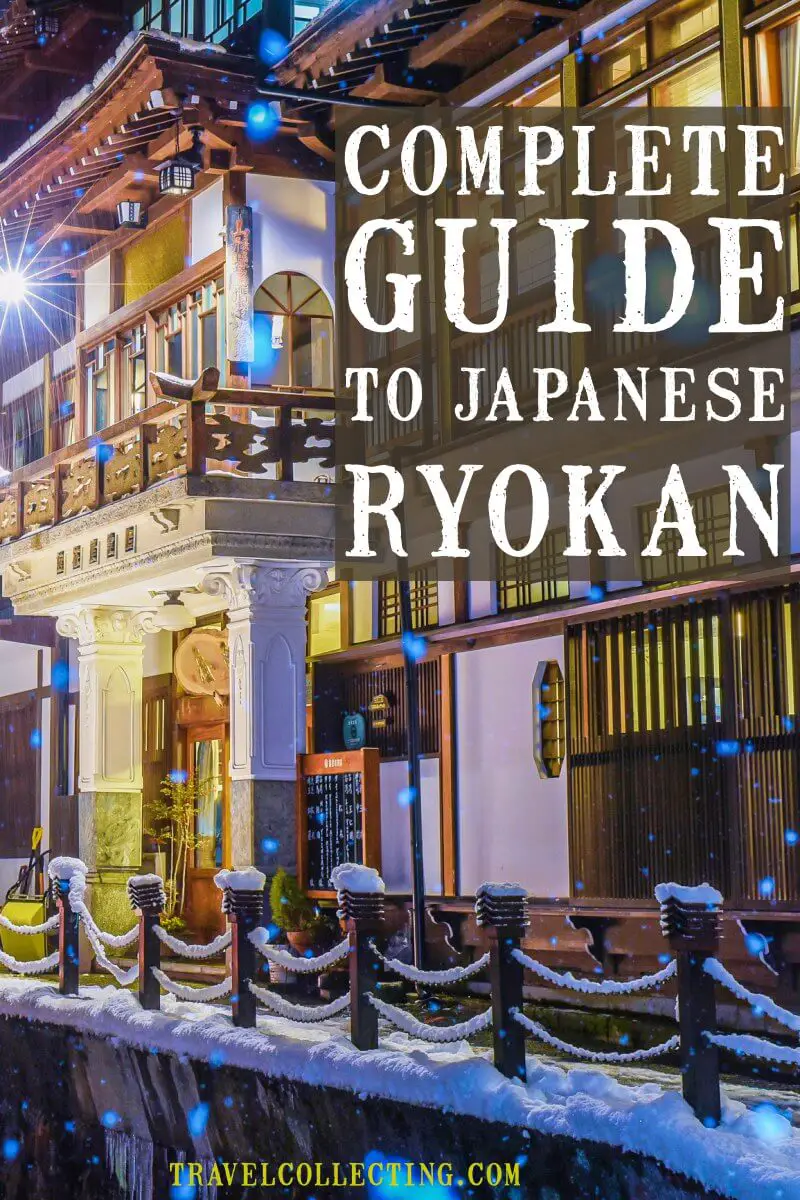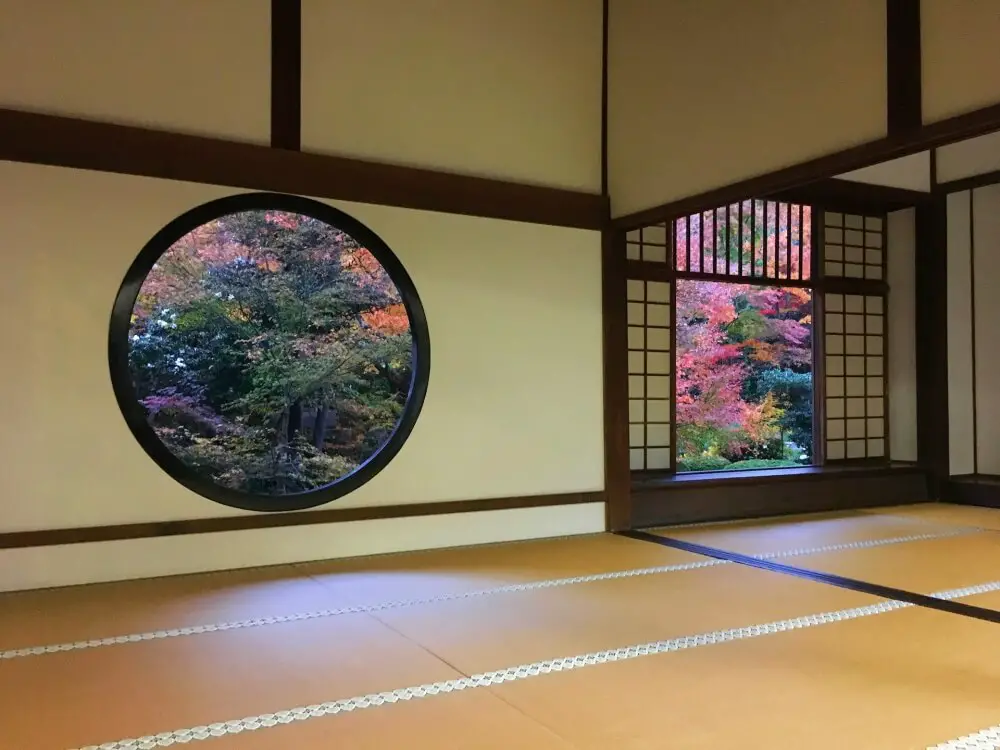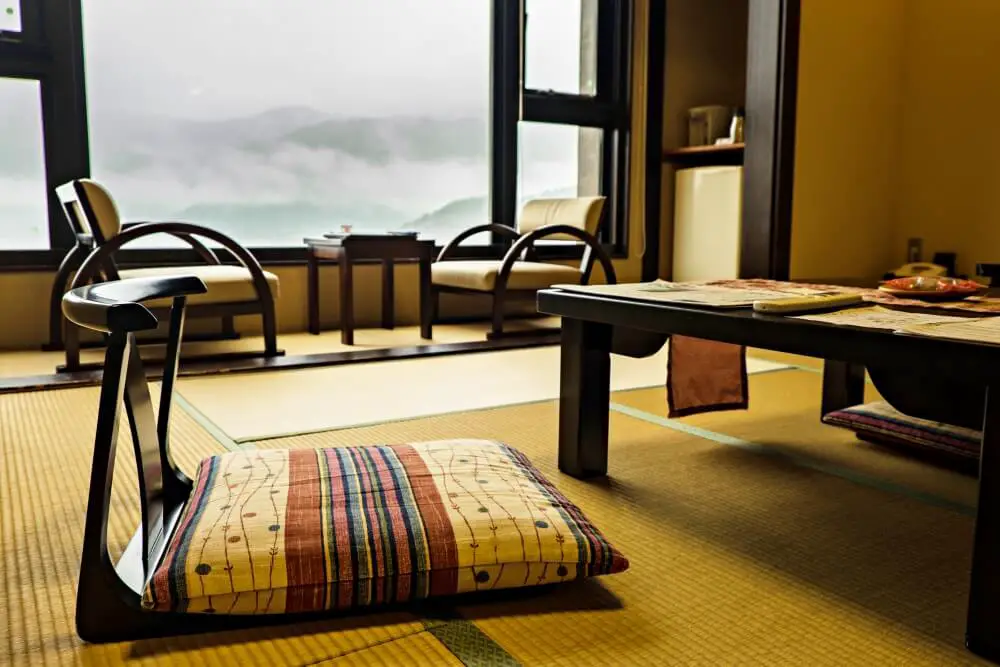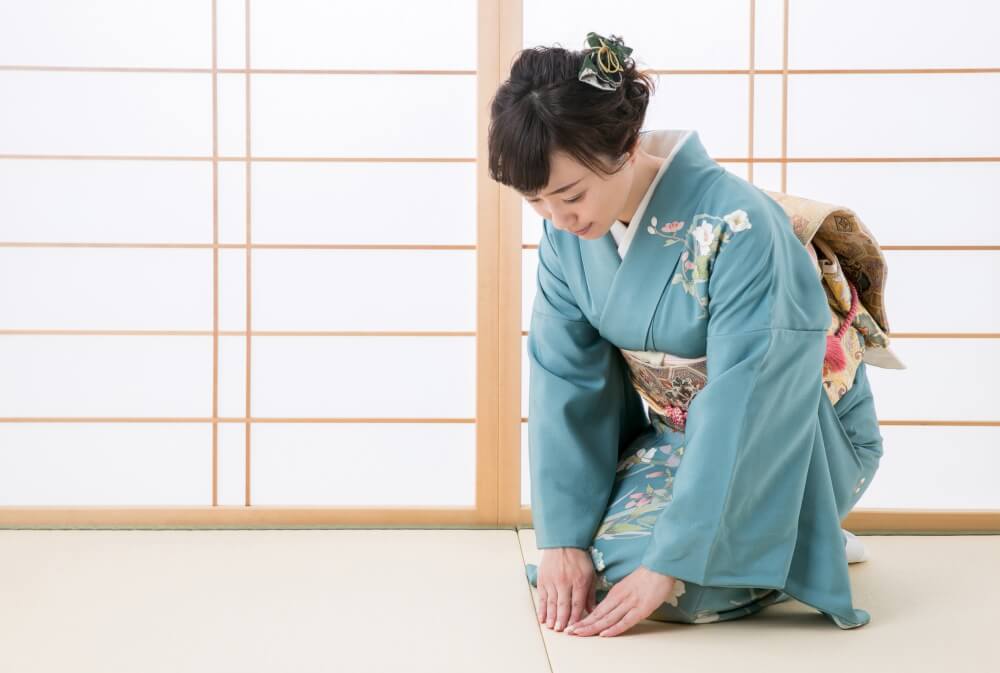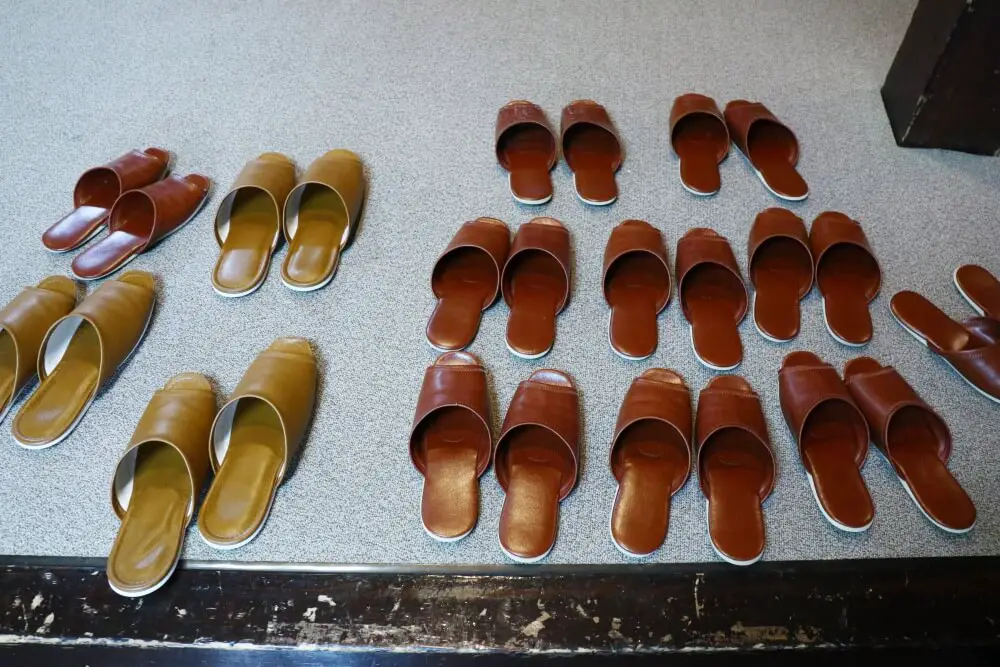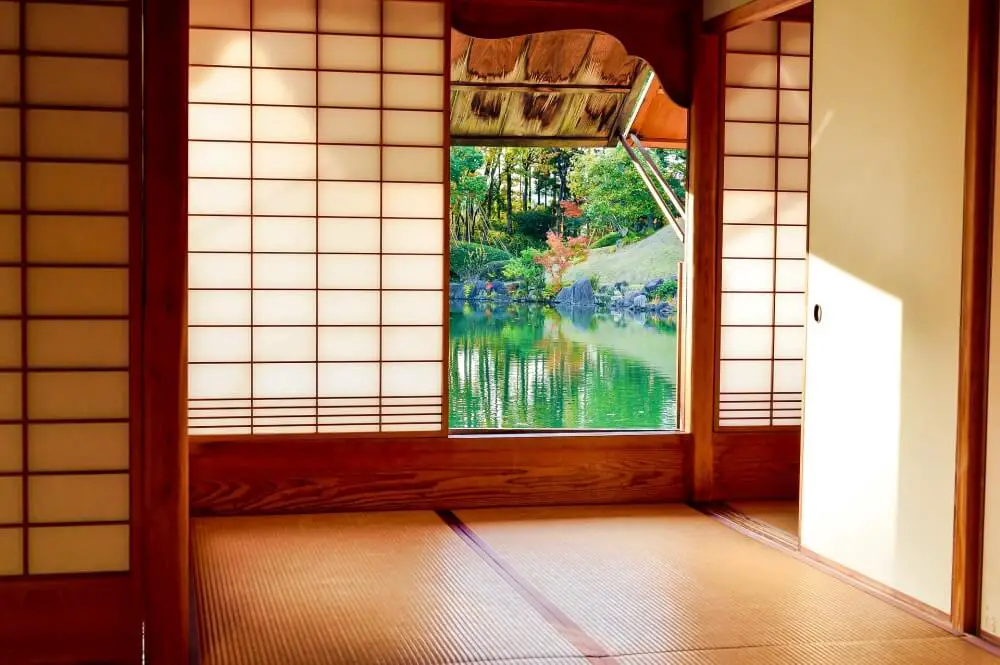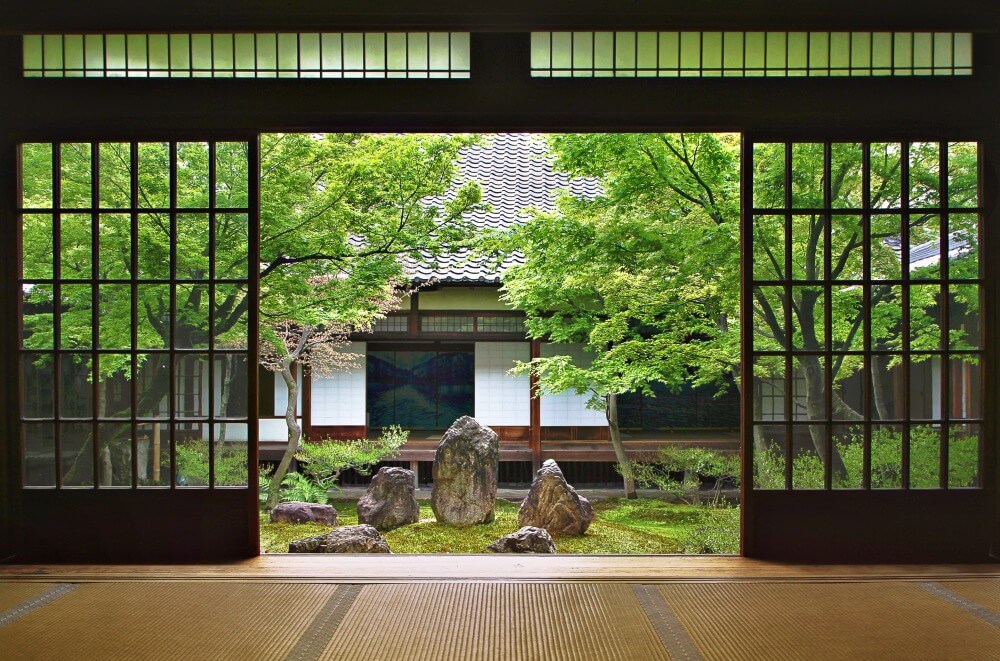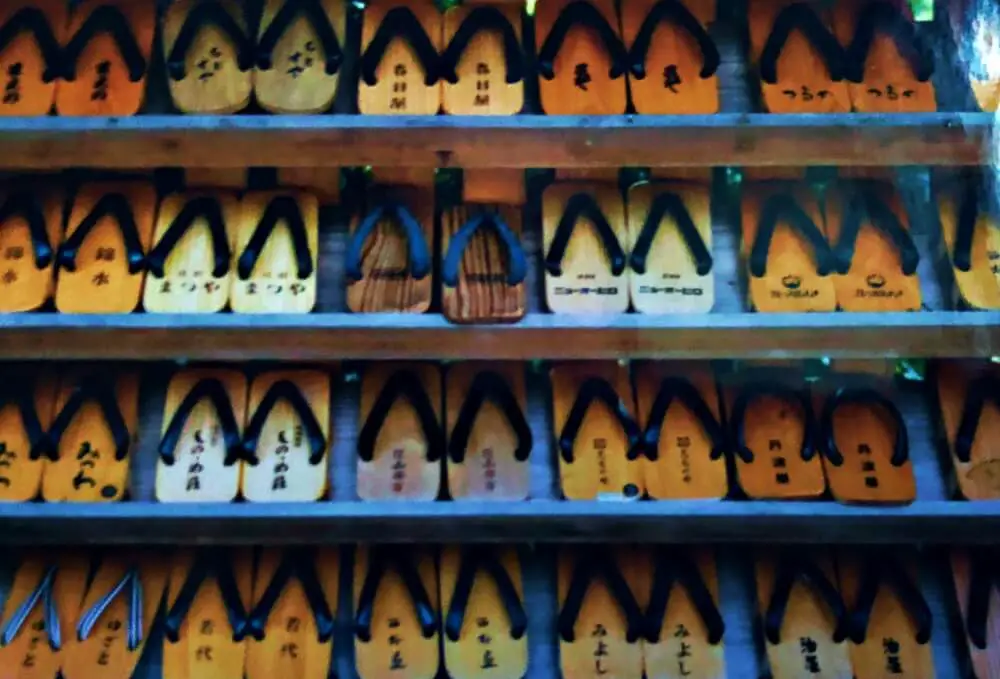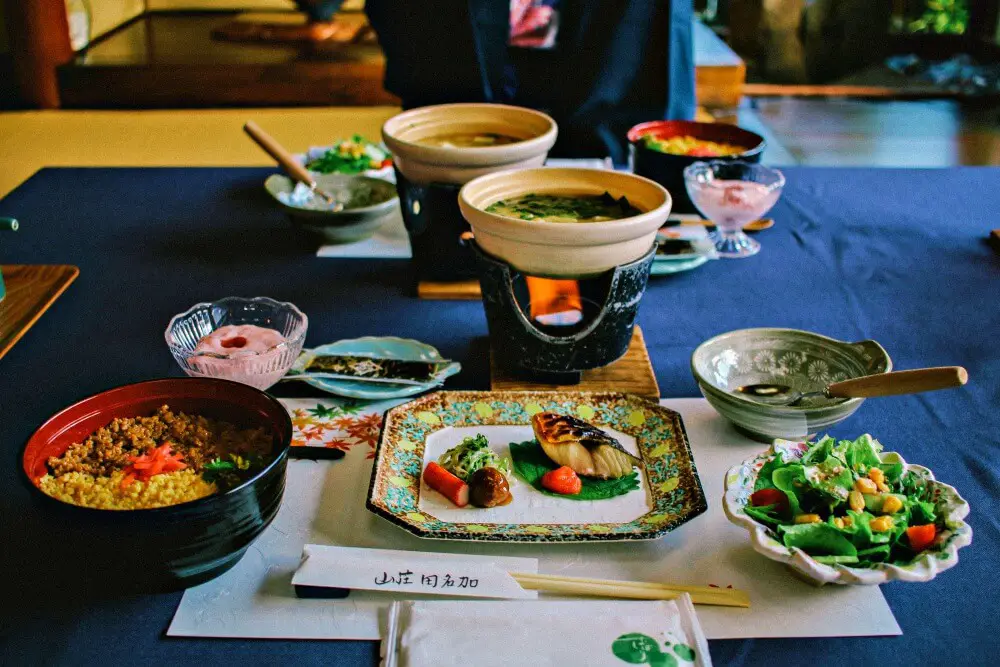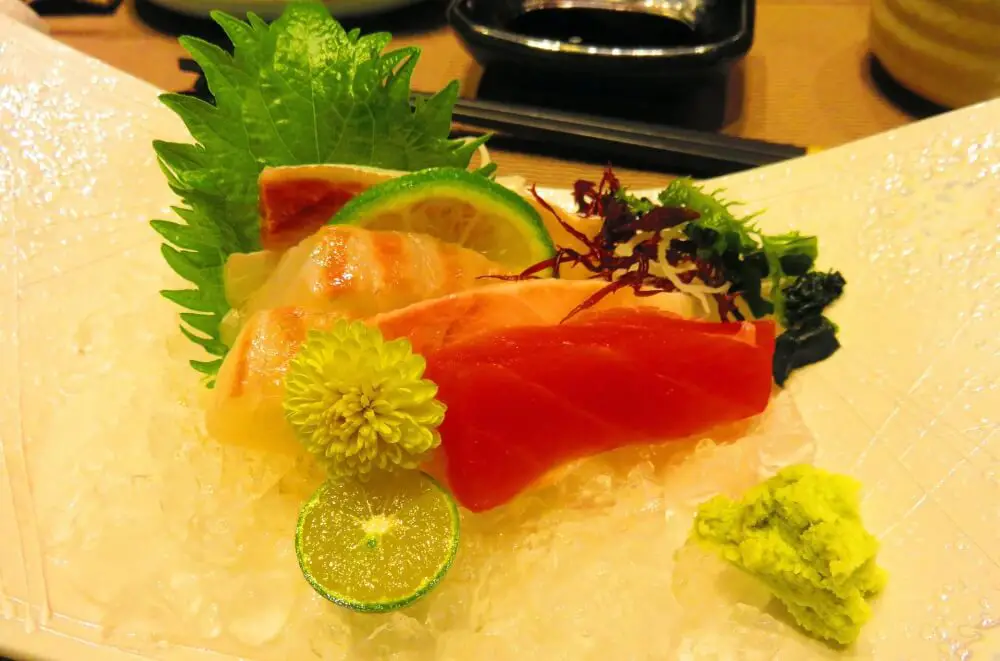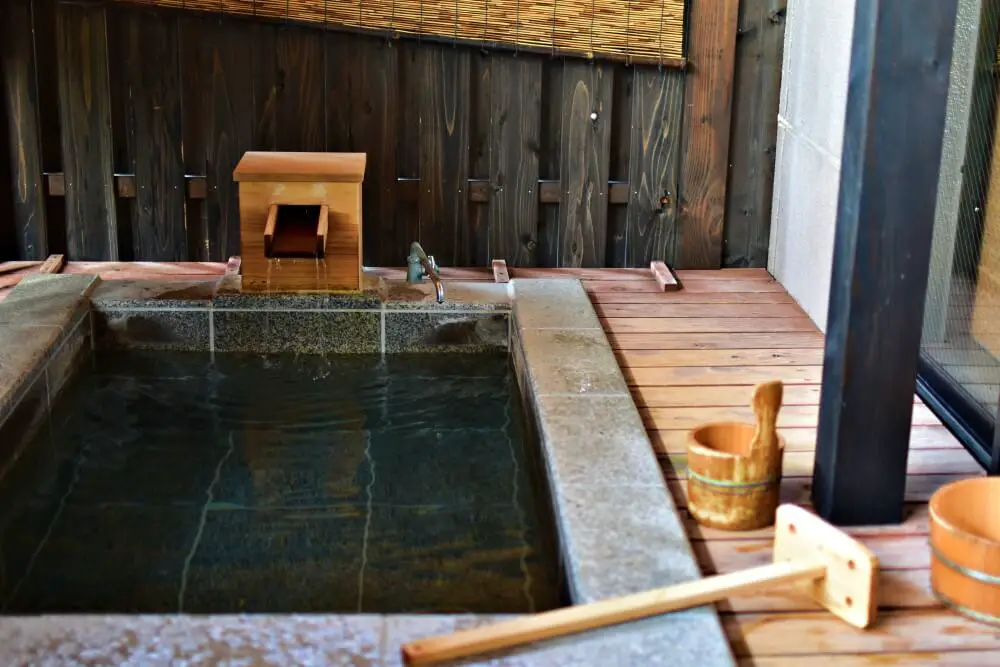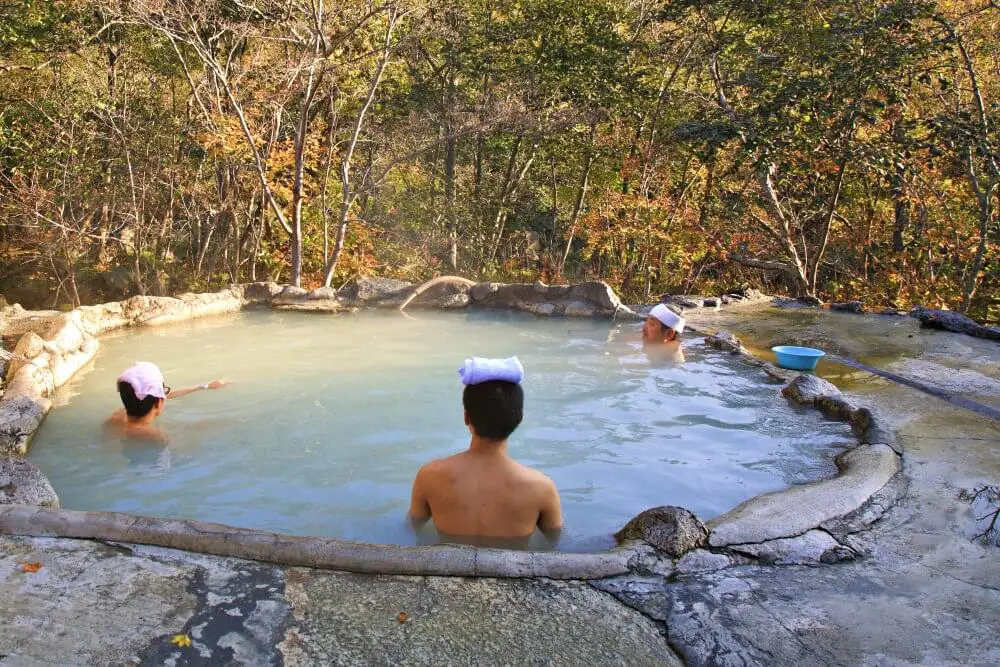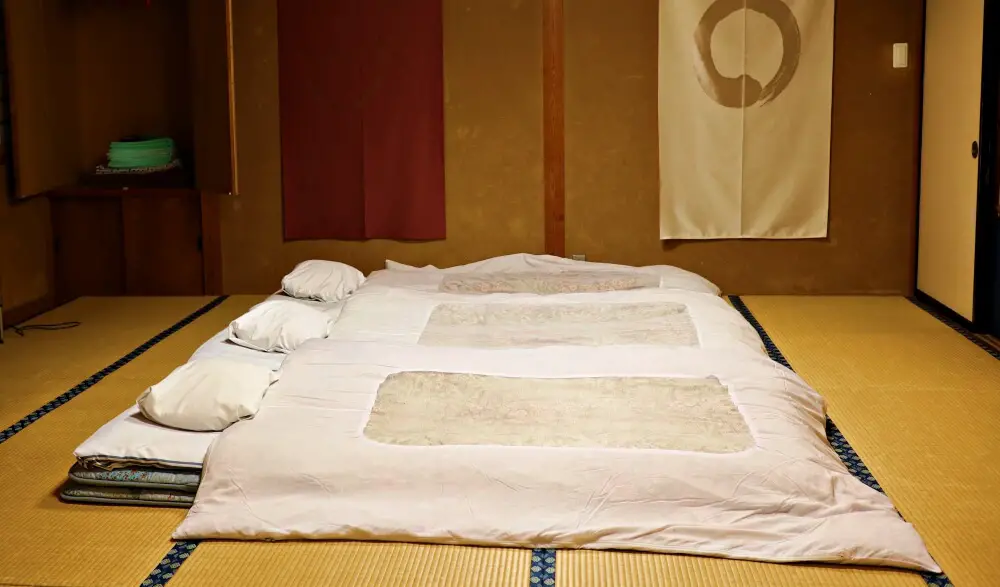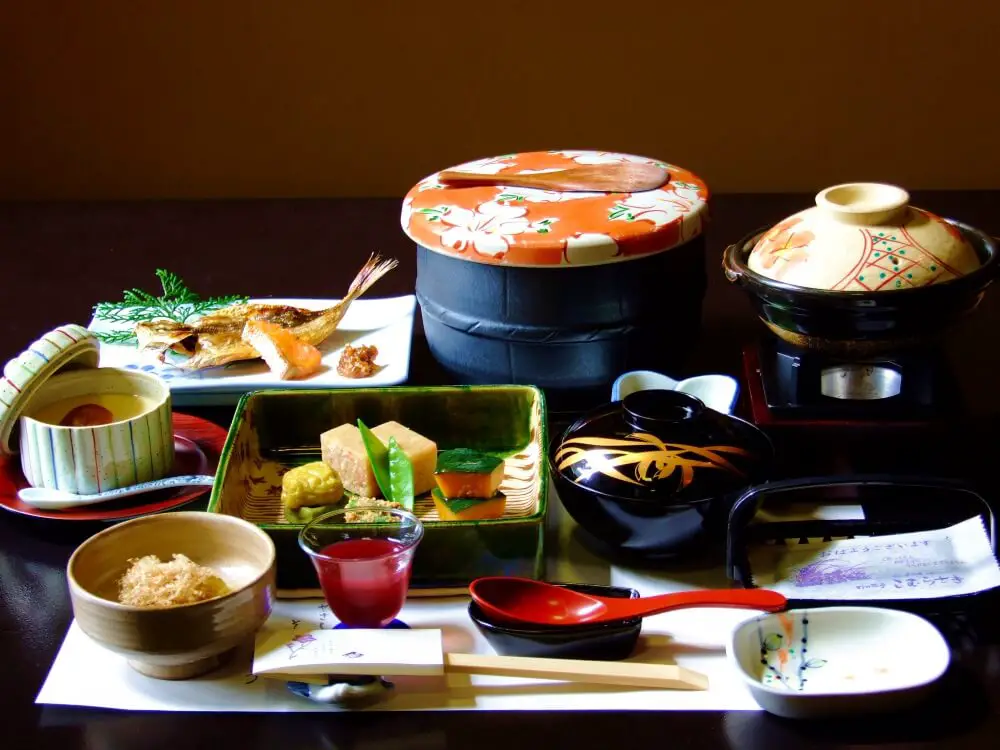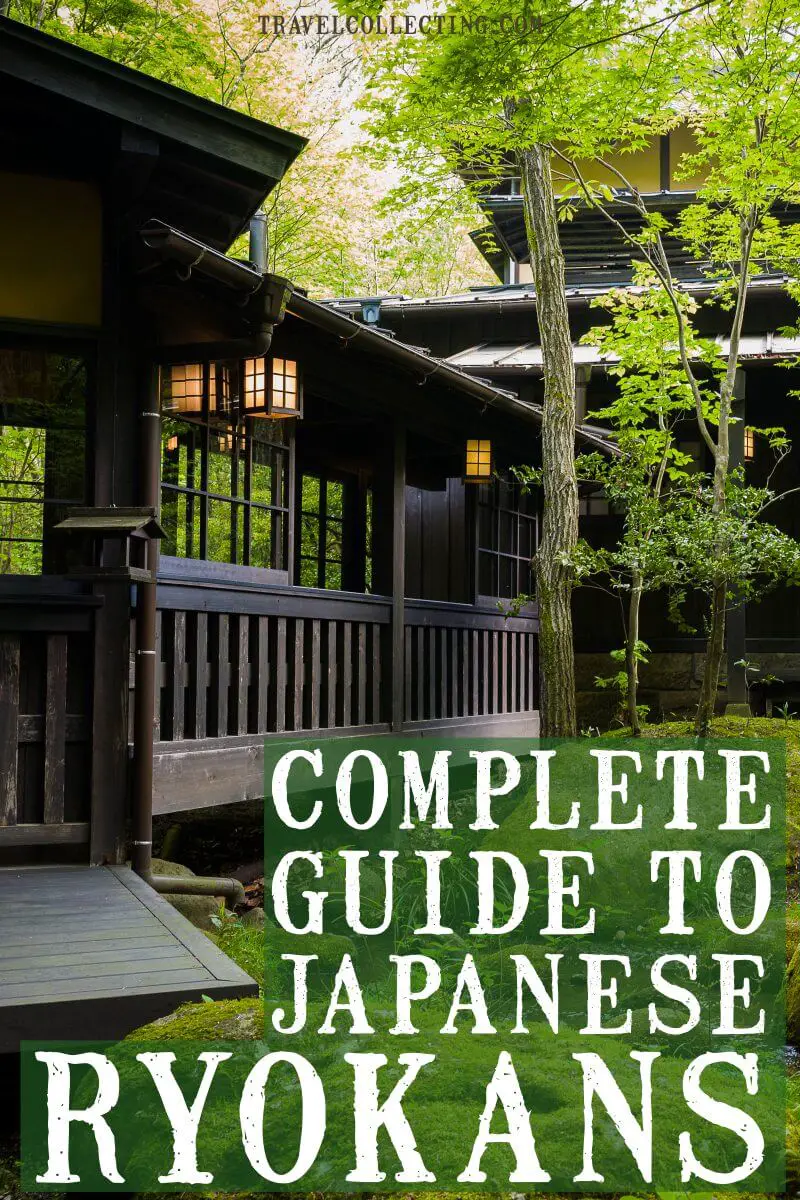The room had grass mat floors, walls made of paper sliding doors latticed with thin wooden strips, plain walls and a nook decorated with a simple, but stylish flower arrangement. A low table with some sweets sat in the middle of the room. I looked around the room, but there was no bed in sight. Through the open paper doors, I could see a beautiful garden courtyard.
I was staying in a traditional Japanese guesthouse.
No time now to read about how to have the best ryokan experience? Pin it and save it for later:
One of the things to decide when planning a trip to Japan is your accommodation. Whether you are visiting a moss temple or having a hanami, where you stay in Japan can really enhance your visit.
So, let’s start with a brief overview of the different types of accommodation in Japan.
Types of hotels in Japan
As with most countries, there are several types of lodging in Japan, including hotels, B&Bs and hostels.
However, in Japan, accommodation is more than just the hostels, business hotels and luxury hotels you are probably used to. There are several types of hotels in Japan that are specific to Japan. These include modern options like capsule hotels and even love hotels (but let’s leave them for another day), plus more traditional options. Staying in these types of accommodations is a great way to immerse yourself more deeply in the culture.
Subscribe to monthly updates with tips for planning, travel inspiration and trip ideas and get instant access to the free PDF of this
Guide To Staying In Traditional Japanese Guesthouses
Traditional accommodation in Japan
Wherever you stay, Japan is a fascinating country to visit; however, a trip to Japan would be incomplete without experiencing a ryokan.
What is a traditional place to stay in Japan?
There are two types of traditional accommodations in Japan – ryokan and minshuku. They are similar but different and we’ll take a look at the differences later on.
Complete Guide to Staying in Traditional Japanese Guesthouses
I love staying in ryokan, but to be honest, I found it intimidating the first time I went to one because I wasn’t sure of the correct protocol. Here is a Complete Guide to Staying in Traditional Japanese Guesthouses with all you need to know so that you will have the best ryokan experience and not feel nervous or uncomfortable about not knowing what to do or what to expect.
But first – a very quick mini lesson in Japanese grammar. Japanese doesn’t have plurals, so there is one kimono and many kimono, one ryokan and many ryokan, and one minshuku and many minshuku. So, you will notice me use the singular (grammatically correct) form throughout.
Best Ryokan in Japan
Want to cut to the chase and see a list of the best ryokan in the country, overall and by region? Check out my complete guide to the best ryokan in Japan.
What is a ryokan in Japan?
So now we have the grammar down, what is a ryokan? A ryokan (Japan has a logical language here – it literally means “travel building” 旅館) is a traditional Japanese inn.
Ryokan (pronounced ree-oh-kun) have been around a long time. Back in the early 8th century people traveled around the country but had nowhere to stay, so inns started to open up along major highways as a place for travelers to stay. The very first one dates from 705 AD. They had basic facilities such as plain rooms with tatami (grass) mats, shared bathrooms and robes provided by the establishment, since travelers didn’t necessarily have appropriate clean indoor clothing to wear.
Today, there are about 60,000 ryokan in Japan. The basic elements have stayed the same through the centuries; there are still tatami floors, communal baths and robes provided for guests and the buildings are usually made of traditional materials such as wood, paper and bamboo.
What has changed, though, is the way that they are used. They are not travelers’ rest stops anymore. Instead, they are destinations in and of themselves. They are a complete cultural experience that is one of the ‘must-do ‘things to do in Japan.
What’s the difference between a traditional Japanese hotel and a regular hotel?
A hotel is usually not much more than a place to stay the night. There is a lobby, often with a bar and lounge, a restaurant attached, and your room has a bed, private bathroom, often with a shower, and a TV.
Ryokan, however, are completely different, and are much more than just a place to sleep. They are an opportunity to experience Japanese culture and a traditional Japanese lifestyle.
Rooms typically have tatami (woven straw) mats rather carpets; futons rather than beds; views on to a quiet garden rather than out on to the street; a communal bath or hot spring rather than a private bathroom with shower; and an elaborate multi-course meal served in your room rather than an a la carte restaurant.
When you stay in a ryokan in Japan, you will be an honored guest, rather than an anonymous tourist. So, in order to maximize your ryokan experience, it’s important to know exactly what to expect.
I remember only too well how nervous – and excited – I was when I first went to one, but I am here to take the mystery out of it for you.
So, let’s look at how to have the best ryokan experience ever.
What to expect at a ryokan?
There are certain rituals and elements that traditional ryokan have. As we take a look, we’ll learn a few Japanese words along the way …
Check in
Check in is usually between 3:00pm and 6:00pm. Don’t plan to arrive later than this, because of the meal (which I’ll talk more about below).
Okami (hostess)
At a traditional Japanese ryokan, you will be met at the door by the mistress (okami) of the ryokan, usually wearing a kimono. She will bow and welcome you to her place. As you probably know, it is typical in Japan to bow rather than shake hands and bowing deeply is a sign of respect. You can nod your head in response to her bow – she will always bow lower than you do, so a nod or dip of the head is a perfectly fine response.
One of the most well-known Japanese traditions is to take your shoes off when you enter a Japanese home and ryokan are no exception. Japanese people consider it very dirty to wear outside shoes, which have been walking on dirty streets, inside the house.
This is in part because Japanese typically sit on the floor at low tables, and even eat at tables when sitting on the floor. Sitting on the same floor someone just walked on in dirty shoes is horrifying.
After living in Japan for three years, I have totally adopted this, and never wear shoes inside my apartment. It makes total sense to me.
There will be a rack in the entrance area to keep your shoes and there are usually slippers next to the entrance for you to wear inside. Keep in mind that you don’t want to walk in your sock on the same dirty floor as your shoes, so the one section is for shoes and you need to step out of your shoes directly on to the ‘inside floor’, which is usually raised slightly.
Tatami (straw mats)
The okami or one of her assistants will show you to your room. Don’t be shocked when you first see it. The room will be almost bare and this is normal. Rooms typically have tatami (woven grass mat) floors. There are large panels of permanently-installed mats. If they have been recently replaced, you will smell the straw. They have a slight spongy feel.
Because you NEVER wear outdoor shoes on tatami, they are quite clean and you can sit on them easily. You should take off your indoor slippers before entering the room – just socks or bare feet are appropriate on the tatami floor.
Be mindful of the tatami and try not to roll your luggage on it – it can be fragile.
There will probably be a low table and either thin cushions or chairs that sit straight on the floor without any legs. There will usually be some wagashi (Japanese sweets) and tea on the table. There is often a nook (called a tokonoma) in one of the walls with an ikebana (flower arrangement) or artwork.
This is your bedroom, but there is no bed (more on that later).
Shoji (paper screen sliding doors)
The room will probably be separated from the neighboring room by sliding shoji paper screens. Yes, that’s right. You could, in theory, open the sliding doors and see your neighbor’s room (but don’t do that). Keep your voice down, as you don’t want to disturb your neighbors. More modern ryokan may not have shoji screens between rooms, but it is likely that they will at least have them facing on to a courtyard garden.
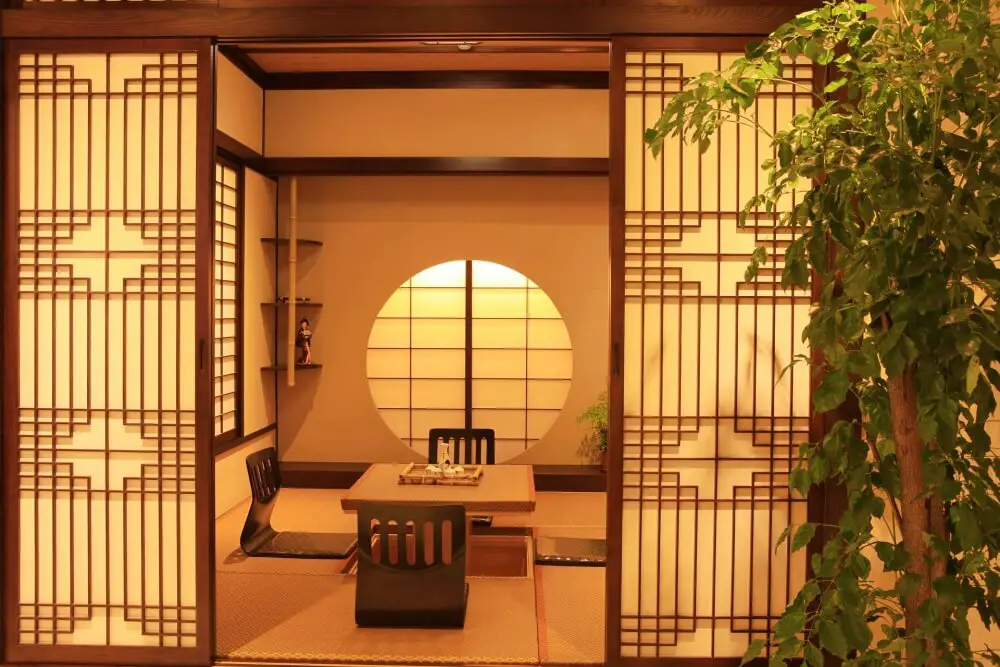
Shibui (simple aesthetic)
Shibui, as defined in Wikipedia, is an “aesthetic of simple, subtle, and unobtrusive beauty … an enriched, subdued appearance or experience of intrinsically fine quality with economy of form, line, and effort, producing a timeless tranquility.” This is evident in the elegant room, but it doesn’t end there.
There is often a large window looking on to a shady garden and a door opening on to a small veranda. The garden will have shady trees, and possibly bamboo, moss and/ or rocks, in the tradition of simple Japanese style and elegance. Ryokan are designed for peaceful relaxation and serenity.
Yukata (cotton robe)
There are almost always yukata provided for you to wear.
What is a yukata?
A yukata is a casual cotton robe, kind of like a kimono but much less formal. They are worn by men and women.
How do you wear a yukata?
It’s pretty simple. Wrap it around your body and have the left side on top. So, fold the right side around your front first and then wrap the left side around on top of that. There will be a thin sash. Wrap this around you a couple of times and then tie it in a bow in front of you. They are traditionally tied at the back, but it is fine to tie them at the front.
The only difference between men and women is that women usually tie the sash around their waist and men tie it around their hips.
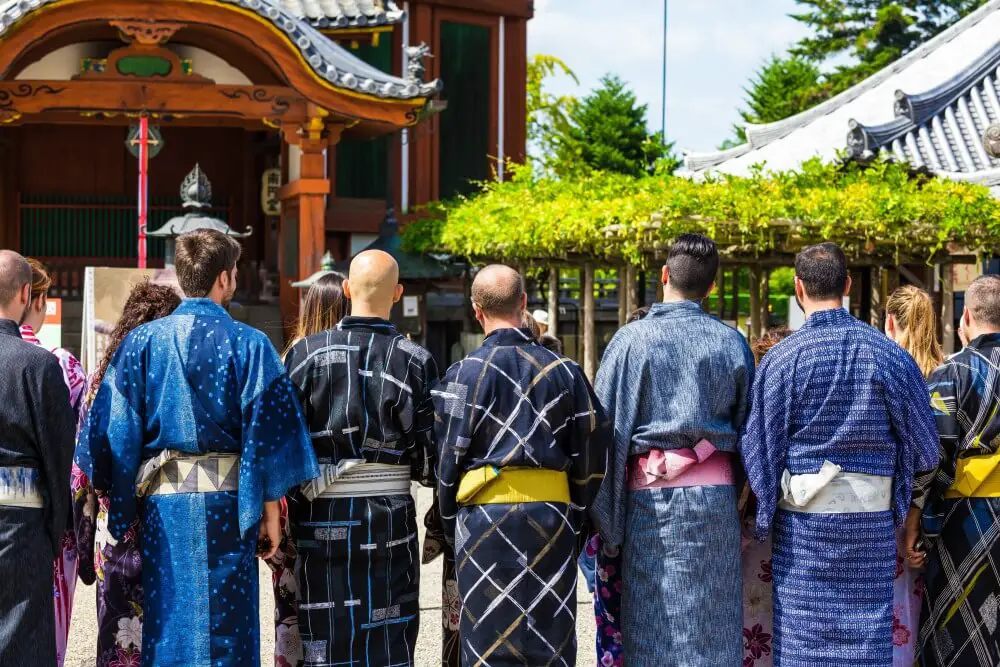
Where do you wear a yukata?
You wear it anywhere in the ryokan. To walk around outside your room, to relax in your room and even to bed if you want. It is comfortable and all of the other guests will be wearing one too.
If you are wondering “Can I wear a yukata outside?”, well, it depends. I wouldn’t wear around the streets of Tokyo, but many ryokan are in small towns where there are loads of hot springs. In those towns, it is very common to walk around the streets on your way to a bathhouse wearing your yukata.
I’ve done this plenty of times, and have even worn a jacket over the yukata when it’s been cold outside.
Geta (wooden slippers)
If you are in a town where it is normal to wear a yukata in the street, you will usually find rows of geta (wooden slippers) by the entrance. These are there for you to borrow and wear.
Clomping around town in wooden slippers and a yukata is a very Japanese experience that is lots of fun. However, the slippers can be uncomfortable, so if you are going to be doing more than just a little walking, you might want to wear your own (outdoor) sandals or flip-flops (which is totally fine).
Kaiseki (gourmet multi-course meal)
After showing you where the yukata is, the assistant will let you know two very important things. Firstly, the meal times, and secondly the bath times (more on that in a moment). This will usually happen with lots of bows and formality. You don’t need to bow in response at this point. But, do note the times, as they are not usually flexible.
Some modern ryokan may have a separate dining area, kind of like a restaurant, with a buffet, but this is not nearly as much fun as having a kaisekii meal, so I would check before booking that they do serve kaiseki. It is part of the ryokan experience.
What is a kaiseki meal?
Kaiseki (懐石) or kaiseki-ryōri (懐石料理) is the Japanese version of haute cuisine. It is food elevated to art and is designed to provide a perfect balance of taste, texture, color and overall appearance. There are multiple courses (usually 10-15).
The meal is served on low tables in your room and the attendant will bring in each course on a tray set on the table. You will sit on a thin cushion or sometimes they will have legless chairs to sit on, so be prepared for that.
The flavors are designed to complement each other perfectly and are usually local and seasonal. Tiny morsels are served on delicate plates decorated with leaves, flowers and colorful pickles and garnishes. If there is one time to Instagram your meal, this is it! It is quite possible that you won’t like everything, but try everything – the servings are small (but there are a lot of them!), so if you don’t like it, just leave it and wait for the next course (though it is considered rude to leave TOO much uneaten).
Having a kaiseki meal is an absolute treat and very rare outside of ryokan, so take your time and savor every moment and every mouthful of your meal. The meal is usually included in the price of the ryokan, which is one reason why staying in a ryokan is usually not very cheap. It is absolutely worth the splurge.
A typical kaiseki meal is (this is from Wikipedia):
- Sakizuke(先附): an appetizer similar to the French amuse-bouche.
- Hassun(八寸): the second course, which sets the seasonal theme. Typically one kind of sushi and several smaller side dishes.
- Mukōzuke(向付): a sliced dish of seasonal sashimi (raw fish).
- Takiawase(煮合): vegetables served with meat, fish or tofu; the ingredients are simmered separately.
- Futamono(蓋物): a “lidded dish”; typically a soup.
- Yakimono(焼物): flame-grilled food (esp. fish)
- Su-zakana(酢肴): a small dish used to cleanse the palate, such as vegetables in vinegar; vinegared appetizer.
- Hiyashi-bachi(冷し鉢): served only in summer; chilled, lightly cooked vegetables.
- Naka-choko(中猪口): another palate-cleanser; may be a light, acidic soup.
- Shiizakana(強肴): a substantial dish, such as a hot pot.
- Gohan(御飯): a rice dish made with seasonal ingredients.
- Kō no mono(香の物): seasonal pickled vegetables.
- Tome-wan(止椀): a miso-based or vegetable soup served with rice.
- Mizumono(水物): a seasonal dessert; may be fruit, confection, ice cream, or cake.
Onsen (hot springs) or Sento (bath)
What is a sento?
Until quite recently, indoor bathrooms did not exist, or at least were not common, in Japan. Instead, everyone bathed daily at a sento (a communal bathhouse). There are still some sento around, though they are much less common now that there are bathrooms in every apartment. However, the tradition of soaking in hot water in a communal bathhouse is very much alive and well.
What is an onsen?
Japan is a string of volcanic islands. The resulting geothermal activity has created hundreds of hot springs (onsen) around the country. Going to an onsen and soaking in mineral-rich geothermal waters is basically a national pastime.
Japanese will often travel long distances around the islands to go to an onsen, and entire towns have long existed around key hot springs. Many onsen towns are prime places for ryokan, so most ryokan around the country have hot springs inside them, and many are situated in towns with public onsen.
Some modern or luxury ryokan have private bathrooms or bathrooms that you can reserve, but most have communal baths. This is all part of the experience and something you should definitely do, but, again, it is good to know in advance what to expect.
Onsen etiquette
A traditional Japanese bathroom has separate areas for cleaning and for soaking. They are almost always separated by sex, but very occasionally they may be mixed-gender. Many ryokan have two – one for men and one for women – but not all. If this is something that would make you feel uncomfortable, check before you book. Some basic things to expect in an onsen:
- You need to get naked. There will be baskets to keep your clothes (probably just your yukata). You will usually get a tiny white towel – this is for modesty when walking around. Wearing swimwear is not an option.
- There is usually a line of showers along a wall, often with a very low stool in front of each one and sometimes with a bucket nearby. There will be soap. Sit on the stool, soap up, and rinse off. You can use the bucket to pour water over your head or to rinse off. Take your time.
- When you’re completely clean, you’re ready to soak. Most onsen are inside, but occasionally there will be an outdoor bath (rotenburo) – a special treat. The water will be hot! NEVER soak in a communal bath without showering first and never put soap in the bath. They are for soaking only; not washing.
- Try not to get your towel inside the bath – keep it on the edge or follow the lead of the Japanese and put it on your head!
Tattoos
Traditionally anyone with tattoos is banned from entering an onsen. Ths is because, until recently, the only people in the country who had tattoos were members of the yakuza (the Japanese mafia), and all yakuza had tattoos. So, by banning tattoos, onsen were effectively banning the yakuza from their premises without expressly doing so. Clever.
This means, though, that foreigners with tattoos are caught in this net and also banned. I have several small tattoos and have never been refused admission to an onsen or asked to leave, though I have friends who have been.
If you have small tattoos, try covering them up with a waterproof Band-Aid. I also covered mine up with my little towel.
If you have a full sleeve of tattoos, or very large tattoos, there is a good chance you will be asked to leave. If this is you, then I would ask the ryokan before you book if they will be OK. Ryokan may be more lenient than a public onsen.
Toile トイレ (Toilet)
A word about using the toilet/ restroom.
The slippers that you wear around the ryokan (or a restaurant if it is one with shoes off) should NEVER be worn into the restroom. Remember, that the whole point of having indoor slippers is to keep everything clean.
Toilet rooms will have plastic slippers by the entrance. Change your slippers – not stepping on the floor of the restroom in your socks, bare feet or indoor slippers. Step on to the bathroom slippers and wear them only inside the restroom.
It is quite possible you will encounter a toilet just like at home; however, there is a very good chance you won’t. Toilets in Japan tend to fall into one of two categories:
Super crazy technological
You can adjust the temperature, the spray, the flush, … you name it, the toilet can probably do it. Trying to figure it out is another thing all together. Either decide to learn and conquer or keep it simple and just do what you always do, ignoring the fancy bells and whistles.
Squat
Yes, Asian-style squat toilets are very common in Japan. Ryokan probably have western-style toilets, but may not. If you are faced with a squat toilet, don’t panic. Face towards the hood. Don’t stand right over the hole – you don’t want to be splashed. There are usually footpads that will indicate where to put your feet. It can be a little hard on the knees if you’re not used to it, but it’s actually better for you, supposedly.
Futon (mattress)
Up until now, there has been no sign of anywhere to sleep in your room. After dinner, while you are soaking in the onsen or walk-in around town, an attendant will clear everything away and lay out a futon for you on the tatami mat floor.
A futon is a thin mattress that is packed away each night. When I lived in Japan, I had an old apartment with tatami mat floors and a futon that I packed away in the closet each day to create a living space during the day. It is the same at a ryokan. There will be a pillow and a cozy comforter.
A futon can be an acquired taste. I love them, but they can be a little thin and hard if you are used to a huge softy bed. However, there is no danger you will roll out of bed!
Breakfast
The next morning, when you get up, fold up the futon and stack it in a corner of your room so that the attendant can set up breakfast. Similar to dinner, you will be served in your room. An attendant will come in and set the meal up on the low table. Breakfast is often Japanese style – think rice and fish.
If you desperately need a western-style breakfast, check with the ryokan before you book to see if this is possible. However, it is worth fully embracing the experience and trying rice for breakfast.
And that is it! If you are just staying one night, check out is typically 10:00am.
Subscribe to monthly updates with tips for planning, travel inspiration and trip ideas and get instant access to the free PDF of this
Guide To Staying In Traditional Japanese Guesthouses
Let’s review soma basic ryokan etiquette.
Ryokan etiquette: 10 do’s and don’ts
- DO take off your shoes at the entrance. Wear socks, indoor slippers (provided) or your bare feet inside.
- DO wear the yukata provided (left side on top).
- DO be mindful of the tatami mats. The straw can break, so DON’T roll your luggage over it. DON’T wear your indoor slippers inside the room – just around the hallways.
- DON’T be late for meals. DO take note of the meal times and bathroom/ onsen times. It is rude to be late and keep the chef and attendants waiting for you to arrive to eat.
- DO try everything in your kaiseki meal if you can. It is considered rude to leave too much of it.
- DO always wash before entering a bathtub.
- DO keep your voice down. Walls are paper thin (literally) and ryokan are considered places for quiet enjoyment.
- >DON’T spill anything – tatami doesn’t like liquids! I spilled some of my soup on the tatami and it was a total nightmare!
- DON’T wear indoor slippers in the restrooms – change into the bathroom slippers.
- DO enjoy the whole experience. This is one of the most fun things you can do in Japan!
Before we end though, there’s one more thing to know.
If you want to experience a ryokan hotel, Japan is the only place in the world to do so. However, a ryokan is only one of two types traditional Japanese guesthouses. The other is a minshuku.
What’s a minshuku?
You may or may not have heard of a minshuku before – they are less famous than their cousin the ryokan, but now I’ve mentioned them, you’re probably wondering “What is a minshuku?” and “What is the difference between them?”
What’s the difference between a ryokan and a minshuku?
Both of them are traditional Japanese accommodation. However, a minshuku is more like a guesthouse or B&B and a ryokan is more like an inn. Even in the United States, you can book a B and B and sometimes it is a room in someone’s house and sometimes it’s more like a small hotel with rooms and breakfast. Well, a minshuku is like the first and a ryokan is more like the latter.
If you want to experience staying in a typical Japanese house, then consider staying in a minshuku. Japan has about 20,000 minshuku scattered across the country. They are often rooms in people’s houses and are usually found in small villages – especially villages built in or around hot springs – or on farms in the mountains or fishermen’s homes on the coast.
What’s a minshuku like?
They are more basic – and cheaper – than a ryokan. They almost always have a shared bath (ryokan often do too, of course) and they are more self-serve. You usually need to lay out your own futon and they don’t always provide a yukata to wear (though I have stayed in minshuku that did). Meals are served in a communal room at a set time.
English is often not spoken. My Japanese is terrible and one time when I stayed at a minshuku with my sister, I totally misunderstood the hostess when she was explaining the rules to me on arrival and we almost missed dinner!
The food isn’t the elaborate multi-course kaiseki that it served is in a ryokan, but is usually local and tasty.
Other than that, though, there are a lot of similarities with ryokan.
The verdict
Staying in a ryokan in Japan is one of the highlights of any trip to Japan. Enjoy the experience!
Best Ryokan in Japan
I have written a complete guide to the best ryokan in Japan. Check it out here for a list of the best ryokan overall and by region.
Subscribe to monthly updates with tips for planning, travel inspiration and trip ideas and get instant access to the free PDF of this
Guide To Staying In Traditional Japanese Guesthouses
Enjoy your stay!
Do you have any stories of Japan? I’d love to hear them. Comment below.
If you liked this post, please share the love and Pin it to your Japan Board!
Read about other Japanese experiences:
- Best ryokan in Japan!
- Cherry blossom viewing in and around Osaka
- Visiting the Saiho-ji | Koke-dera moss temple in Kyoto
About the author

James Ian has traveled to 83 countries and all 7 continents. He is passionate about experiential travel, i.e. meaningful travel that actively engages with the environment and culture. He helps people have similar experiences that involve active participation in activities and festivals; engaging with the local food and handicrafts through lessons and food tours; and interacting positively with environment by hiking, riding, rowing, diving and low/no impact animal encounters.

